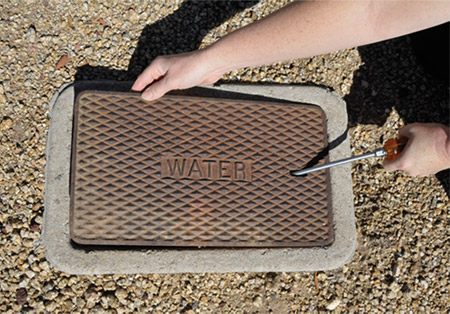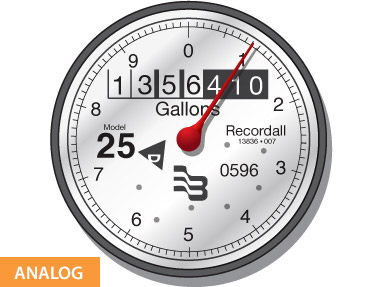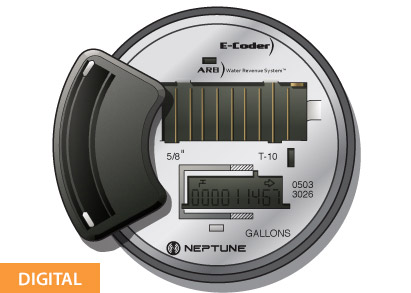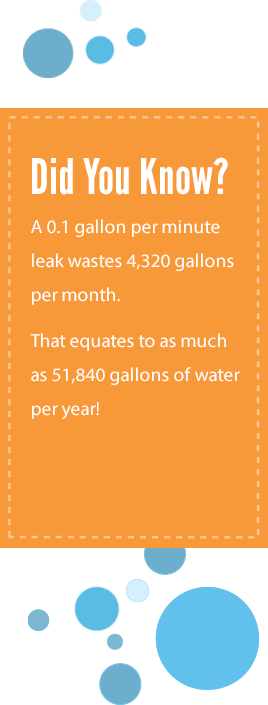What is a Water Meter?
A water meter is a device that measures the volume of water delivered to a property. Some water meters measure water in gallons while others measure in cubic feet.
Most residential water meters are located near the curb or sidewalk at the front of the property in a concrete "box." The water meter box will have a metal or plastic lid and may be marked, "Water Meter."
Use a long screwdriver to remove the lid. However, be cautious as insects, reptiles or other small animals occasionally take residence inside the boxes. Some water meters will have a small, hinged cover while others may not. Lift the cover and use a damp rag to wipe the face clean.
Next
Understanding the Water Meter
Look at your water meter to determine if you have an analog (dial) or a digital display. Instructions for reading both types of water meters are included in this section.
Reading the Analog Display
The large sweep hand on the dial measures water use in gallons or cubic feet. One gallon or one cubic foot of water passes through the water meter as the sweep hand moves from one number to the next (e.g., 0 to 1). A complete rotation equals 10 gallons or 10 cubic feet depending on the unit measured. Most analog dials have a low-flow indicator that turns as water moves through the water meter. This typically looks like a small triangle (shown), star or gear.
Analog Example: The sweep hand is on the "1" so the read is 1,356,411 gallons. The last number on the right is a static zero (does not change). When the sweep hand is on the "3" the read will be 1,356,413 gallons. When you record your reading in the Leak Detection Test, make sure to use the number indicated by the sweep arm as the final digit.

Activating and Reading the Digital Display (LCD)
The digital meter needs light for activation so you may need to shine a flashlight on it. The display alternates between the meter read and the flow rate. The meter read equals the gallons (or cubic feet) used while the flow rate equals the number of gallons (or cubic feet) per minute flowing through the water meter. Some digital meters allow review of historical water use. This feature helps track water use trends such as when leaks have occurred. Check your water provider's website for more information.
Next
Leak Detection Test
Once you know how to read your water meter, you can begin to check for the presence of continuous leaks by following the procedure below. Do not use water or operate any water-using devices in or around your home during the test.
Step-by-Step Instructions
For Analog Display Meters
- Observe the sweep hand. If it is moving, you have a continuous leak.
- Observe the low-flow indicator. If it is moving, you have a continuous leak.
-
Some leaks are so small that the movement is almost undetectable. To determine if you have a slow leak:
- Read your water meter and record the numbers in the boxes we've provided ("Fill in your meter readingsFill in your meter readings"). Use the number indicated by the sweep arm as the final digit.
- Wait 20 minutes then read your water meter again and record the numbers.
- Subtract the first water meter reading from the second.
- If Gallons Used is greater than zero you have a continuous leak.
For Digital Display (LCD) Meters
- Observe the flow rate screen for at least 10 flashes. If the number is greater than zero on any of the flashes, you have a continuous leak.
- Some leaks are very slow and may not show as a continuous flow. To determine if you have a slow leak follow Step 3 above.
Example of the presence of a continuous leak:
Fill in your meter readings:
Wait 20 minutes between taking meter readings. Enter readings below to determine number of gallons used.

Methods to Detect the Location of Leaks
This guide provides two methods to detect the location of leaks: the Isolation Method and the Visual Inspection Method. A brief description of both methods follows.
Isolation Method

The purpose of the Isolation Method is to isolate different sections of the plumbing in and around your home. If your Leak Detection Test (Section 1) indicated a continuous leak, consider using the Isolation Method to discover the leak location. This is often the quickest way to locate ongoing, hard-to-find leaks. You will turn water supply valves "off" to prevent water from flowing into water supply pipes. If you are comfortable turning valves on and off, go to Isolation Method for Continuous Leaks (Section 4).
Visual Inspection Method
Conduct the Visual Inspection Method if you did not detect a continuous leak when you performed the Leak Detection Test (Section 1) or if you are uncomfortable with the Isolation Method. Use the checklists in the Outdoor Visual Leak Inspection (Section 2) and Indoor Visual Leak Inspection (Section 3) to conduct visual leak inspections around your home.

Did You Know?
A 0.1 gallon per minute leak wastes 4,320 gallons per month.
That equates to as much as 51,840 gallons of water per year!